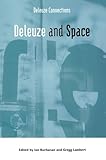Deleuze and space / edited by Ian Buchanan and Gregg Lambert.
Series: Deleuze connectionsPublication details: Edinburgh : Edinburgh University Press, c2005.Description: vi, 245 p. : ill. ; 24 cmISBN:- 0748618929
- 9781474480956
- 0748618740
| Item type | Current library | Collection | Call number | Status | Date due | Barcode | |
|---|---|---|---|---|---|---|---|
 Book
Book
|
CGLAS Library | Red | 194 DEL (Browse shelf(Opens below)) | Available | 06656 |
Includes bibliographical references and index.
Introduction-Deleuze and Space -- Chapter 1 Space in the Age of Non-Place -- Chapter 2 To See with the Mind and Think through the Eye: Deleuze, Folding Architecture, and Simon Rodia's Watts Towers -- Chapter 3 Stealing into Gilles Deleuze's Baroque House -- Chapter 4 Space: Extensive and Intensive, Actual and Virtual -- Chapter 5 'Genesis Eternal': After Paul Klee -- Chapter 6 After Informatic Striation: The Resignification of Disc Numbers in Contemporary Inuit Popular Culture -- Chapter 7 Thinking Leaving -- Chapter 8 On the 'Spiritual Automaton', Space and Time in Modern Cinema According to Gilles Deleuze -- Chapter 9 Ahab and Becoming-Whale: The Nomadic Subject in Smooth Space -- Chapter 10 Transcendental Aesthetics: Deleuze's Philosophy of Space -- Chapter 11 The Space of Man: On the Specificity of Affect in Deleuze and Guattari -- Chapter 12 The Desert Island Tom Conley -- Chapter 13 What the Earth Thinks
Gilles Deleuze was arguably the twentieth century's most spatial philosopher - not only did he contribute a plethora of new concepts to engage space, space was his very means of doing philosophy. He said everything takes place on a plane of immanence, envisaging a vast desert-like space populated by concepts moving about like nomads. Deleuze made philosophy spatial and gave us the concepts of smooth and striated, nomadic and sedentary, deterritorialization and reterritorialization, the fold, as well as many others to enable us to think spatially.This collection takes up the challenge of thinking spatially by exploring Deleuze's spatial concepts in applied contexts: architecture, cinema, urban planning, political philosophy and metaphysics. In doing so, it brings together some of the most accomplished Deleuze scholars writing today - Réda Bensmaîa, Ian Buchanan, Claire Colebrook, Tom Conley, Manuel DeLanda, Gary Genosko, Gregg Lambert and Nigel Thrift.A volume in the Deleuze Connections series, edited by Ian Buchanan. Other titles in the series include Deleuze and Feminist Theory, Deleuze and Literature, Deleuze and Music, and Deleuze and Geophilosophy.

